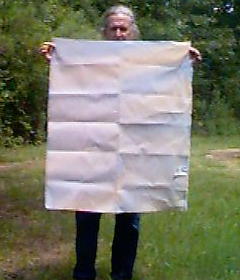|
Obtaining round ball patches for a .32 caliber squirrel rifle is a problem here in the backwoods. The local Wal-Mart Heck, I could cut square patches with scissors! Nothing for me to do but see if Sam knew what he was talking about.
First, patching material must be (1) 100% cotton and (2) must be tightly woven and (3) must measure between .014 and .018 in thickness. I started by micrometer measuring the 100% cotton clothing in my closets. Nothing met the requirements but new T-shirts. So, micrometer in hand, off I headed to the fabric section in the local Wal-Mart I quickly discovered that almost all the bolts of cotton fabric contained 35% to 75% polyester. The few 100% cotton bolts I found measured .007 to .009. Alas, my hopes of having brightly colored patches died. Then I put the micrometer to a bolt of 100% cotton pillow ticking. It read .018".
"$3.17," she said. That's me holding it in the photo on the right. It measured 36" x 33". That's somewhere around 2,000 .32 caliber patches. To look at it in reference to money, that's more than 600 patches for a dollar or around 6 patches for a penny. Any way you look at it, it spells Cheap with a capital C. To mark it for cutting I flattened it in the middle of my kitchen floor. I decided to cut it in 3/4" strips and to cut only two strips since that would give me 80+ patches. Using a black felt tip pen, I made black dots along opposite edges and spaced 3/4" apart. (Since the store-cut edge was crooked, I cut it out.) Then I aligned an edge of a 1" x 6" board on two opposite dots. Then I stood on the board so it would hold the fabric in place, and I then drew a line along the edge of the board, connecting the two dots.
To cut the 3/4" patches from the 33" strips, I aligned a CD jewel case 3/4" from the edge of my kitchen table, gently shoved the end of a strip against it, and cut it with scissors aligned with the edge of the table. Quick, easy, simple. If you prefer to cut your patches on the muzzle with a patch knife, leave the material in strips. If you shoot a .50 or .54 caliber rifle, determine the size of your square patches by measuring the diameter of a round patch. I lubed my square patches with Cold Weather Junior Lube and headed for the range. It was time to see if ol' Sam knew what he was talking about. Here's a sampling of the results and with a penny included for scale:
A pleasant surprise was the great results with the Lee .311 cast round ball. With .014 round patches it had performed poorly. So not only have I bought my last package of factory-made patches, I've bought my last box of factory-made round balls. Thanks, Sam.
REFERENCES
|




